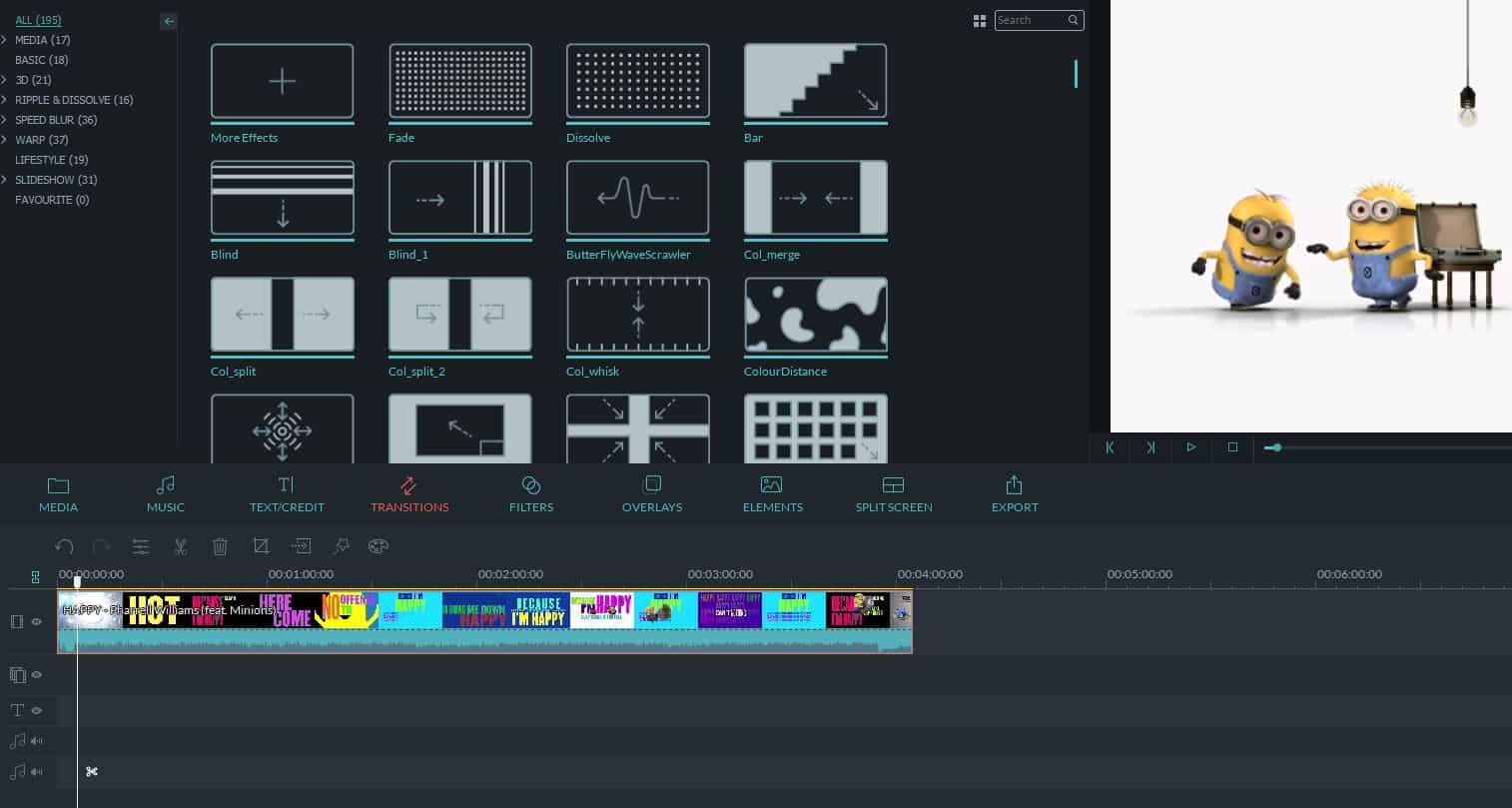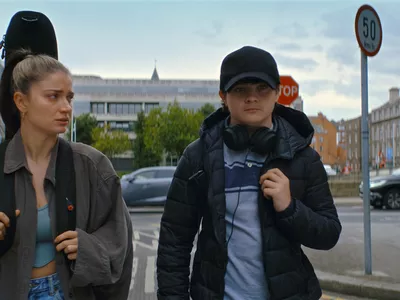
Updated 2024 Approved Unlocking Advanced Video Editing Picture-in-Picture in Final Cut Pro

Unlocking Advanced Video Editing: Picture-in-Picture in Final Cut Pro
How to Create a Picture-in-Picture Effect Using Final Cut Pro

Benjamin Arango
Mar 27, 2024• Proven solutions
Sometimes we need to show two videos together on the same screen to convey certain usage information. If you are searching for a tool to make this task possible then Final Cut Pro is the best choice for you.
This tool can help you to use the picture-in-picture effect with ease. However, the process for adding this effect cannot be completed within one r two steps.
The article below contains complete details about how to add PIP effects using Final Cut Pro. You will be glad to know that FCP also works with few integrated plugins that assist in the free picture in picture effect generation.
How to Create PIP Effect with FCP
If you are ready with two videos and now want to bring them to the same screen then prefer to follow these simple steps:
Step 1: Add Background video
The very first step that you need to follow for PIP effect generation using FCP is to bring your main or background video to the timeline as a primary storyline. Once you have created the primary storyline then all videos for the PIP effect will be added to it.
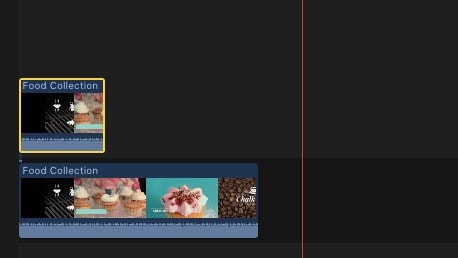
Step 2: Add PIP videos
It is time to choose the higher video clip so that the PIP effect can be applied. This task can be done either by using on-screen type controls available on the viewer or you can move ahead with transform controls available on the inspector.
Note that lower clips use to stay in the background in final results whereas upper clips will appear in the foreground. By default, both clips use to have 100% full screen with 100% opaque settings.
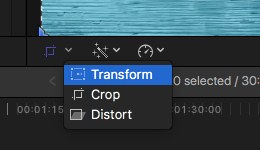
Step 3: Apply PIP effect
As now you have added both videos on-screen now you have to select the higher video and then click over the rectangular transform button that is available on the lower-left corner of viewer screen. As soon as you make this selection, the icon will turn into blue color, and naturally 8 dots will appear around the selected image or video. Use any one of these dots for scaling your selection in asymmetrical order.
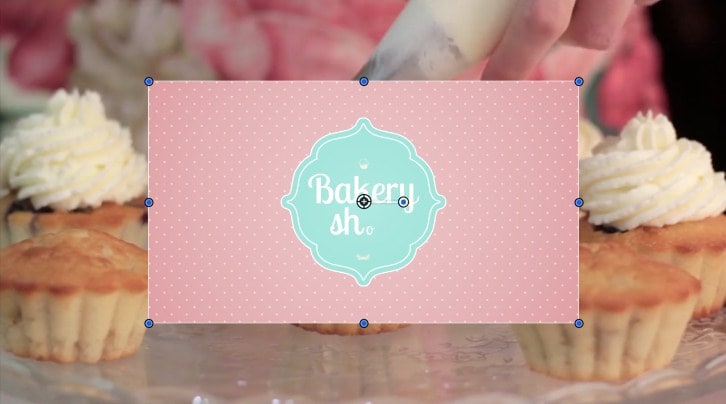
Step 4: Adjust PIP Effect
- If you want to scale this image in a symmetrical fashion then simply drag the dot to the corner from the central position.
- Now hold the option key and drag one dot to the corner. It will help you to shrink as well as to enlarge the image even without affecting its actual aspect ratio.
- Users can keep on scaling this foreground image till the time they achieve essential size.
- Now click inside your selected image and start dragging it to reach a certain specific position. You can place it anywhere on a big screen.
Step 5: Follow precise Adjustment
Simply select the top clip and then hit Command + 4 to open the inspector. Now click on that blue show button over your FCP screen and it will provide you complete information about the transform category of available built-in effects. If you use inspector for this task then it can help you to get very precise results for scaling needs. It assists users to manage images with accurate position and size.

Step 6: Apply Cross- Dissolve
- Now choose the leading edge of effect and use Command + T. It will immediately apply the default cross-dissolve option for starting clip.
- You will be glad to know that the PIP effect does not restrict users to work just upon a single image rather it can be used to process as many pictures as your project needs and that can fit inside the frame.
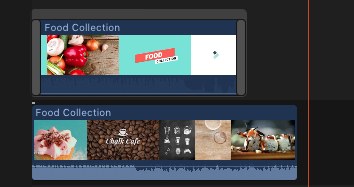
Check this video tutorial to know more details:
Picture in Picture Plug-ins for Final Cut Pro
There are so many plug-ins available in the market for Final Cut Pro platform and all of them possess unique qualities along with impressive toolsets. No matter whether you are a beginner with the PIP effect or professional making high-end video projects, FCP plug-ins can make your task much easier with their intuitive controls.
1. Tokyo PiPintor
PiPintor Free is a specially designed picture-in-picture plugin that assists beginners with easy processing of the PIP effect over Final Cut Pro platform. It simply awakes the menu-driven animation power on your tool so that picture in picture effect can be completed without key-framing.
2. ProPIP
Those who need to enjoy a higher level of customizations are advised to work over ProPIP environment. This advanced tool assists users to showcase their abilities with full freedom for personalization.
ProPIP is the best choice for newscasting, commentaries, and many other applications. It helps in generating fine controls for initial as well as end position, rotation, and scaling effects along with easy-to-use media controls over the screen. ProPIP also provides personalized borders with endless opportunities to develop impressive projects on Final Cut Pro platform.

Benjamin Arango
Benjamin Arango is a writer and a lover of all things video.
Follow @Benjamin Arango
Benjamin Arango
Mar 27, 2024• Proven solutions
Sometimes we need to show two videos together on the same screen to convey certain usage information. If you are searching for a tool to make this task possible then Final Cut Pro is the best choice for you.
This tool can help you to use the picture-in-picture effect with ease. However, the process for adding this effect cannot be completed within one r two steps.
The article below contains complete details about how to add PIP effects using Final Cut Pro. You will be glad to know that FCP also works with few integrated plugins that assist in the free picture in picture effect generation.
How to Create PIP Effect with FCP
If you are ready with two videos and now want to bring them to the same screen then prefer to follow these simple steps:
Step 1: Add Background video
The very first step that you need to follow for PIP effect generation using FCP is to bring your main or background video to the timeline as a primary storyline. Once you have created the primary storyline then all videos for the PIP effect will be added to it.

Step 2: Add PIP videos
It is time to choose the higher video clip so that the PIP effect can be applied. This task can be done either by using on-screen type controls available on the viewer or you can move ahead with transform controls available on the inspector.
Note that lower clips use to stay in the background in final results whereas upper clips will appear in the foreground. By default, both clips use to have 100% full screen with 100% opaque settings.

Step 3: Apply PIP effect
As now you have added both videos on-screen now you have to select the higher video and then click over the rectangular transform button that is available on the lower-left corner of viewer screen. As soon as you make this selection, the icon will turn into blue color, and naturally 8 dots will appear around the selected image or video. Use any one of these dots for scaling your selection in asymmetrical order.

Step 4: Adjust PIP Effect
- If you want to scale this image in a symmetrical fashion then simply drag the dot to the corner from the central position.
- Now hold the option key and drag one dot to the corner. It will help you to shrink as well as to enlarge the image even without affecting its actual aspect ratio.
- Users can keep on scaling this foreground image till the time they achieve essential size.
- Now click inside your selected image and start dragging it to reach a certain specific position. You can place it anywhere on a big screen.
Step 5: Follow precise Adjustment
Simply select the top clip and then hit Command + 4 to open the inspector. Now click on that blue show button over your FCP screen and it will provide you complete information about the transform category of available built-in effects. If you use inspector for this task then it can help you to get very precise results for scaling needs. It assists users to manage images with accurate position and size.

Step 6: Apply Cross- Dissolve
- Now choose the leading edge of effect and use Command + T. It will immediately apply the default cross-dissolve option for starting clip.
- You will be glad to know that the PIP effect does not restrict users to work just upon a single image rather it can be used to process as many pictures as your project needs and that can fit inside the frame.

Check this video tutorial to know more details:
Picture in Picture Plug-ins for Final Cut Pro
There are so many plug-ins available in the market for Final Cut Pro platform and all of them possess unique qualities along with impressive toolsets. No matter whether you are a beginner with the PIP effect or professional making high-end video projects, FCP plug-ins can make your task much easier with their intuitive controls.
1. Tokyo PiPintor
PiPintor Free is a specially designed picture-in-picture plugin that assists beginners with easy processing of the PIP effect over Final Cut Pro platform. It simply awakes the menu-driven animation power on your tool so that picture in picture effect can be completed without key-framing.
2. ProPIP
Those who need to enjoy a higher level of customizations are advised to work over ProPIP environment. This advanced tool assists users to showcase their abilities with full freedom for personalization.
ProPIP is the best choice for newscasting, commentaries, and many other applications. It helps in generating fine controls for initial as well as end position, rotation, and scaling effects along with easy-to-use media controls over the screen. ProPIP also provides personalized borders with endless opportunities to develop impressive projects on Final Cut Pro platform.

Benjamin Arango
Benjamin Arango is a writer and a lover of all things video.
Follow @Benjamin Arango
Benjamin Arango
Mar 27, 2024• Proven solutions
Sometimes we need to show two videos together on the same screen to convey certain usage information. If you are searching for a tool to make this task possible then Final Cut Pro is the best choice for you.
This tool can help you to use the picture-in-picture effect with ease. However, the process for adding this effect cannot be completed within one r two steps.
The article below contains complete details about how to add PIP effects using Final Cut Pro. You will be glad to know that FCP also works with few integrated plugins that assist in the free picture in picture effect generation.
How to Create PIP Effect with FCP
If you are ready with two videos and now want to bring them to the same screen then prefer to follow these simple steps:
Step 1: Add Background video
The very first step that you need to follow for PIP effect generation using FCP is to bring your main or background video to the timeline as a primary storyline. Once you have created the primary storyline then all videos for the PIP effect will be added to it.

Step 2: Add PIP videos
It is time to choose the higher video clip so that the PIP effect can be applied. This task can be done either by using on-screen type controls available on the viewer or you can move ahead with transform controls available on the inspector.
Note that lower clips use to stay in the background in final results whereas upper clips will appear in the foreground. By default, both clips use to have 100% full screen with 100% opaque settings.

Step 3: Apply PIP effect
As now you have added both videos on-screen now you have to select the higher video and then click over the rectangular transform button that is available on the lower-left corner of viewer screen. As soon as you make this selection, the icon will turn into blue color, and naturally 8 dots will appear around the selected image or video. Use any one of these dots for scaling your selection in asymmetrical order.

Step 4: Adjust PIP Effect
- If you want to scale this image in a symmetrical fashion then simply drag the dot to the corner from the central position.
- Now hold the option key and drag one dot to the corner. It will help you to shrink as well as to enlarge the image even without affecting its actual aspect ratio.
- Users can keep on scaling this foreground image till the time they achieve essential size.
- Now click inside your selected image and start dragging it to reach a certain specific position. You can place it anywhere on a big screen.
Step 5: Follow precise Adjustment
Simply select the top clip and then hit Command + 4 to open the inspector. Now click on that blue show button over your FCP screen and it will provide you complete information about the transform category of available built-in effects. If you use inspector for this task then it can help you to get very precise results for scaling needs. It assists users to manage images with accurate position and size.

Step 6: Apply Cross- Dissolve
- Now choose the leading edge of effect and use Command + T. It will immediately apply the default cross-dissolve option for starting clip.
- You will be glad to know that the PIP effect does not restrict users to work just upon a single image rather it can be used to process as many pictures as your project needs and that can fit inside the frame.

Check this video tutorial to know more details:
Picture in Picture Plug-ins for Final Cut Pro
There are so many plug-ins available in the market for Final Cut Pro platform and all of them possess unique qualities along with impressive toolsets. No matter whether you are a beginner with the PIP effect or professional making high-end video projects, FCP plug-ins can make your task much easier with their intuitive controls.
1. Tokyo PiPintor
PiPintor Free is a specially designed picture-in-picture plugin that assists beginners with easy processing of the PIP effect over Final Cut Pro platform. It simply awakes the menu-driven animation power on your tool so that picture in picture effect can be completed without key-framing.
2. ProPIP
Those who need to enjoy a higher level of customizations are advised to work over ProPIP environment. This advanced tool assists users to showcase their abilities with full freedom for personalization.
ProPIP is the best choice for newscasting, commentaries, and many other applications. It helps in generating fine controls for initial as well as end position, rotation, and scaling effects along with easy-to-use media controls over the screen. ProPIP also provides personalized borders with endless opportunities to develop impressive projects on Final Cut Pro platform.

Benjamin Arango
Benjamin Arango is a writer and a lover of all things video.
Follow @Benjamin Arango
Benjamin Arango
Mar 27, 2024• Proven solutions
Sometimes we need to show two videos together on the same screen to convey certain usage information. If you are searching for a tool to make this task possible then Final Cut Pro is the best choice for you.
This tool can help you to use the picture-in-picture effect with ease. However, the process for adding this effect cannot be completed within one r two steps.
The article below contains complete details about how to add PIP effects using Final Cut Pro. You will be glad to know that FCP also works with few integrated plugins that assist in the free picture in picture effect generation.
How to Create PIP Effect with FCP
If you are ready with two videos and now want to bring them to the same screen then prefer to follow these simple steps:
Step 1: Add Background video
The very first step that you need to follow for PIP effect generation using FCP is to bring your main or background video to the timeline as a primary storyline. Once you have created the primary storyline then all videos for the PIP effect will be added to it.

Step 2: Add PIP videos
It is time to choose the higher video clip so that the PIP effect can be applied. This task can be done either by using on-screen type controls available on the viewer or you can move ahead with transform controls available on the inspector.
Note that lower clips use to stay in the background in final results whereas upper clips will appear in the foreground. By default, both clips use to have 100% full screen with 100% opaque settings.

Step 3: Apply PIP effect
As now you have added both videos on-screen now you have to select the higher video and then click over the rectangular transform button that is available on the lower-left corner of viewer screen. As soon as you make this selection, the icon will turn into blue color, and naturally 8 dots will appear around the selected image or video. Use any one of these dots for scaling your selection in asymmetrical order.

Step 4: Adjust PIP Effect
- If you want to scale this image in a symmetrical fashion then simply drag the dot to the corner from the central position.
- Now hold the option key and drag one dot to the corner. It will help you to shrink as well as to enlarge the image even without affecting its actual aspect ratio.
- Users can keep on scaling this foreground image till the time they achieve essential size.
- Now click inside your selected image and start dragging it to reach a certain specific position. You can place it anywhere on a big screen.
Step 5: Follow precise Adjustment
Simply select the top clip and then hit Command + 4 to open the inspector. Now click on that blue show button over your FCP screen and it will provide you complete information about the transform category of available built-in effects. If you use inspector for this task then it can help you to get very precise results for scaling needs. It assists users to manage images with accurate position and size.

Step 6: Apply Cross- Dissolve
- Now choose the leading edge of effect and use Command + T. It will immediately apply the default cross-dissolve option for starting clip.
- You will be glad to know that the PIP effect does not restrict users to work just upon a single image rather it can be used to process as many pictures as your project needs and that can fit inside the frame.

Check this video tutorial to know more details:
Picture in Picture Plug-ins for Final Cut Pro
There are so many plug-ins available in the market for Final Cut Pro platform and all of them possess unique qualities along with impressive toolsets. No matter whether you are a beginner with the PIP effect or professional making high-end video projects, FCP plug-ins can make your task much easier with their intuitive controls.
1. Tokyo PiPintor
PiPintor Free is a specially designed picture-in-picture plugin that assists beginners with easy processing of the PIP effect over Final Cut Pro platform. It simply awakes the menu-driven animation power on your tool so that picture in picture effect can be completed without key-framing.
2. ProPIP
Those who need to enjoy a higher level of customizations are advised to work over ProPIP environment. This advanced tool assists users to showcase their abilities with full freedom for personalization.
ProPIP is the best choice for newscasting, commentaries, and many other applications. It helps in generating fine controls for initial as well as end position, rotation, and scaling effects along with easy-to-use media controls over the screen. ProPIP also provides personalized borders with endless opportunities to develop impressive projects on Final Cut Pro platform.

Benjamin Arango
Benjamin Arango is a writer and a lover of all things video.
Follow @Benjamin Arango
Unlock Your Creativity: How to Edit MP4 Videos on Mac and Windows Computers
How to Edit MP4 Video in Mac/Windows (Windows 8 included)

Ollie Mattison
Mar 27, 2024• Proven solutions
MP4 is a very common media format that can keep the high image and sound quality. Many downloaded movies, streaming music videos, or recorded video clips are with .MP4 file extension. Confused about different kinds of formats? Check out this video to learn what video format is and the differences between video formats.
If you have many such files, chances are that you need to edit MP4 videos.
Although various MP4 editors are available on the market, they are a little space-consuming in order to ensure good performance. Here I’d like to share a powerful and efficient MP4 editor that designed for beginners and hobbyists.
It’s Wondershare Filmora (originally Wondershare Video Editor). With it, you’re able to trim, rotate, crop, merge MP4 files, as well as personalize your MP4 videos with rich text, filter and transitions. Moreover, after you finish MP4 video editing, you can directly share your creation on YouTube, Facebook, or save to any format you want.
All-in-one MP4 Editor to Edit MP4 File [Free to Download]
Wondershare MP4 Video Editor
- Supports almost all kinds of MP4 files, including AVC, XVID, MPEG-4 and more.
- Crop, trim, cut, split and combine - edit MP4 videos in a few clicks.
- Easily edit MP4 videos with 300+ styles and audio/visual effects.
- Provides advanced MP4 video editing tools like Tilt Shift, Face off, Mosaic, Jump Cut, etc.
- Burn to DVD or convert to any popular video format.
- Convert video to formats compatible on various mobile devices or upload to YouTube and Facebook instantly.
How to Easily Edit MP4 Video?
Before we proceed to illustrate every detail on how to edit the MP4 video, you can download the MP4 editor first so you can follow the below steps one by one.
It’s free to download now.
1. Cut MP4 Video
To cut your MP4 video into certain parts, drag and drop the video on the Timeline and highlight it. Then place the red Time Indicator to where you want to cut the video, and click the Scissor button above the timeline.
After that, move the red marker to the end of the scene, and repeat this again to cut the video into several fragments. If you want to cut off the unwanted parts, right click the video and choose “Delete”.
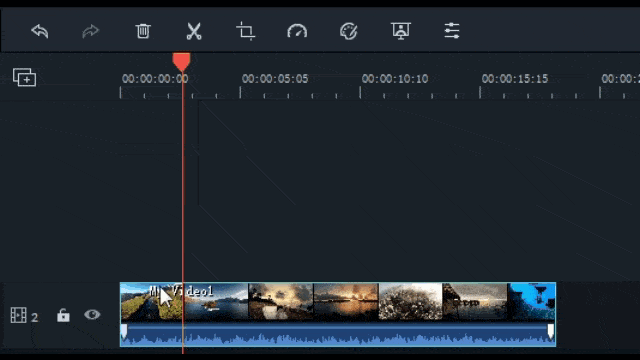
2. Join MP4 Video
To join several MP4 video files into one, you just need to place all the video files on the timeline, adjust the order and hit “Create” to export it.
If you want to make the joined videos look like a really intact movie, just add transitions between clips for smooth change from one to next. To do this, click “Transition” tab on the main screen. Then drag the effect you like to the timeline to apply.
If you don’t want to choose the transition one by one, let the software choose the transition randomly by right clicking and selecting “Random to All” option.
3. Edit the audio of MP4 Video
Sometimes you may need to adjust the settings of audio. To do it, double click the video on the Timeline. Then a editing panel will pop up. Switch to the Audio column and you can easily change the Speed, Volume, Pitch of the audio file or add the Fade in/out effect to it.
Want to change the original audio track of your MP4 video?
No problem.
Just highlight your MP4 video, right click and choose “Audio Detach”. The audio file of your video will immediately be separated and appear on the music timeline. Since it is separated from the video, you can easily delete the audio track or replace it with your own music.

4. Add 300+ Effects to Touch Up MP4 Video
Besides the basic video editing functions, Video Editor also provides various stunning scene effects to take your MP4 (MPEG-4) video to a higher level:
- Different transitions & motion effects are provided to make your video animated.
- Pre-made Intro/Credit makes your video like a real movie.
- 100+ funny cliparts to adorn your MP4 video with much more fun.
- More special effects like PIP, Jump Cut, Face Off, Tilt-shift for you to try!

5. Save or Share the Edited Video
When all the editing is done, hit “Create” to save or share your videos in different ways:
- Export as standard or high-quality MP4 format or MOV, AVI and more formats.
- Premiere your video on iPhone, iPad, Galaxy, HTC and more mobile devices.
- Burn to DVD to preserve or share, super fast.
- Directly upload your video to Facebook and YouTube.
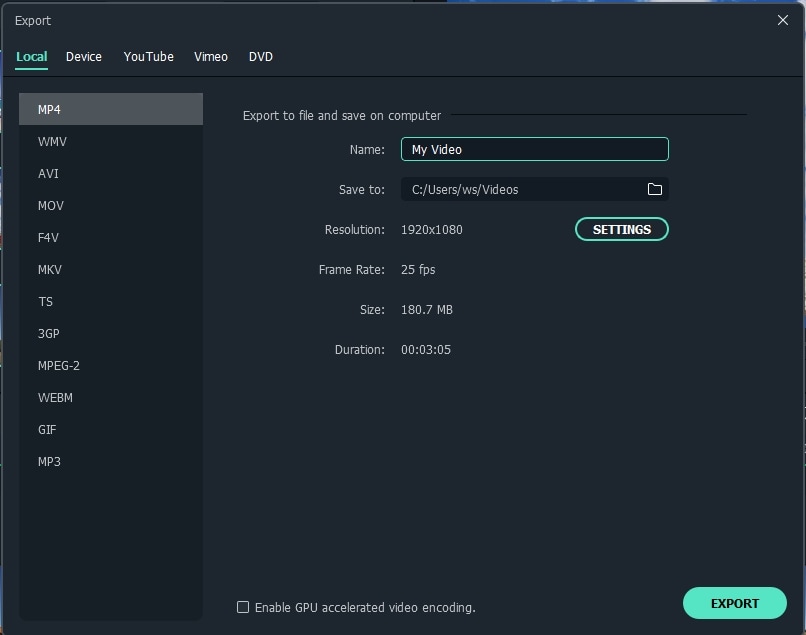

Ollie Mattison
Ollie Mattison is a writer and a lover of all things video.
Follow @Ollie Mattison
Ollie Mattison
Mar 27, 2024• Proven solutions
MP4 is a very common media format that can keep the high image and sound quality. Many downloaded movies, streaming music videos, or recorded video clips are with .MP4 file extension. Confused about different kinds of formats? Check out this video to learn what video format is and the differences between video formats.
If you have many such files, chances are that you need to edit MP4 videos.
Although various MP4 editors are available on the market, they are a little space-consuming in order to ensure good performance. Here I’d like to share a powerful and efficient MP4 editor that designed for beginners and hobbyists.
It’s Wondershare Filmora (originally Wondershare Video Editor). With it, you’re able to trim, rotate, crop, merge MP4 files, as well as personalize your MP4 videos with rich text, filter and transitions. Moreover, after you finish MP4 video editing, you can directly share your creation on YouTube, Facebook, or save to any format you want.
All-in-one MP4 Editor to Edit MP4 File [Free to Download]
Wondershare MP4 Video Editor
- Supports almost all kinds of MP4 files, including AVC, XVID, MPEG-4 and more.
- Crop, trim, cut, split and combine - edit MP4 videos in a few clicks.
- Easily edit MP4 videos with 300+ styles and audio/visual effects.
- Provides advanced MP4 video editing tools like Tilt Shift, Face off, Mosaic, Jump Cut, etc.
- Burn to DVD or convert to any popular video format.
- Convert video to formats compatible on various mobile devices or upload to YouTube and Facebook instantly.
How to Easily Edit MP4 Video?
Before we proceed to illustrate every detail on how to edit the MP4 video, you can download the MP4 editor first so you can follow the below steps one by one.
It’s free to download now.
1. Cut MP4 Video
To cut your MP4 video into certain parts, drag and drop the video on the Timeline and highlight it. Then place the red Time Indicator to where you want to cut the video, and click the Scissor button above the timeline.
After that, move the red marker to the end of the scene, and repeat this again to cut the video into several fragments. If you want to cut off the unwanted parts, right click the video and choose “Delete”.

2. Join MP4 Video
To join several MP4 video files into one, you just need to place all the video files on the timeline, adjust the order and hit “Create” to export it.
If you want to make the joined videos look like a really intact movie, just add transitions between clips for smooth change from one to next. To do this, click “Transition” tab on the main screen. Then drag the effect you like to the timeline to apply.
If you don’t want to choose the transition one by one, let the software choose the transition randomly by right clicking and selecting “Random to All” option.
3. Edit the audio of MP4 Video
Sometimes you may need to adjust the settings of audio. To do it, double click the video on the Timeline. Then a editing panel will pop up. Switch to the Audio column and you can easily change the Speed, Volume, Pitch of the audio file or add the Fade in/out effect to it.
Want to change the original audio track of your MP4 video?
No problem.
Just highlight your MP4 video, right click and choose “Audio Detach”. The audio file of your video will immediately be separated and appear on the music timeline. Since it is separated from the video, you can easily delete the audio track or replace it with your own music.

4. Add 300+ Effects to Touch Up MP4 Video
Besides the basic video editing functions, Video Editor also provides various stunning scene effects to take your MP4 (MPEG-4) video to a higher level:
- Different transitions & motion effects are provided to make your video animated.
- Pre-made Intro/Credit makes your video like a real movie.
- 100+ funny cliparts to adorn your MP4 video with much more fun.
- More special effects like PIP, Jump Cut, Face Off, Tilt-shift for you to try!

5. Save or Share the Edited Video
When all the editing is done, hit “Create” to save or share your videos in different ways:
- Export as standard or high-quality MP4 format or MOV, AVI and more formats.
- Premiere your video on iPhone, iPad, Galaxy, HTC and more mobile devices.
- Burn to DVD to preserve or share, super fast.
- Directly upload your video to Facebook and YouTube.


Ollie Mattison
Ollie Mattison is a writer and a lover of all things video.
Follow @Ollie Mattison
Ollie Mattison
Mar 27, 2024• Proven solutions
MP4 is a very common media format that can keep the high image and sound quality. Many downloaded movies, streaming music videos, or recorded video clips are with .MP4 file extension. Confused about different kinds of formats? Check out this video to learn what video format is and the differences between video formats.
If you have many such files, chances are that you need to edit MP4 videos.
Although various MP4 editors are available on the market, they are a little space-consuming in order to ensure good performance. Here I’d like to share a powerful and efficient MP4 editor that designed for beginners and hobbyists.
It’s Wondershare Filmora (originally Wondershare Video Editor). With it, you’re able to trim, rotate, crop, merge MP4 files, as well as personalize your MP4 videos with rich text, filter and transitions. Moreover, after you finish MP4 video editing, you can directly share your creation on YouTube, Facebook, or save to any format you want.
All-in-one MP4 Editor to Edit MP4 File [Free to Download]
Wondershare MP4 Video Editor
- Supports almost all kinds of MP4 files, including AVC, XVID, MPEG-4 and more.
- Crop, trim, cut, split and combine - edit MP4 videos in a few clicks.
- Easily edit MP4 videos with 300+ styles and audio/visual effects.
- Provides advanced MP4 video editing tools like Tilt Shift, Face off, Mosaic, Jump Cut, etc.
- Burn to DVD or convert to any popular video format.
- Convert video to formats compatible on various mobile devices or upload to YouTube and Facebook instantly.
How to Easily Edit MP4 Video?
Before we proceed to illustrate every detail on how to edit the MP4 video, you can download the MP4 editor first so you can follow the below steps one by one.
It’s free to download now.
1. Cut MP4 Video
To cut your MP4 video into certain parts, drag and drop the video on the Timeline and highlight it. Then place the red Time Indicator to where you want to cut the video, and click the Scissor button above the timeline.
After that, move the red marker to the end of the scene, and repeat this again to cut the video into several fragments. If you want to cut off the unwanted parts, right click the video and choose “Delete”.

2. Join MP4 Video
To join several MP4 video files into one, you just need to place all the video files on the timeline, adjust the order and hit “Create” to export it.
If you want to make the joined videos look like a really intact movie, just add transitions between clips for smooth change from one to next. To do this, click “Transition” tab on the main screen. Then drag the effect you like to the timeline to apply.
If you don’t want to choose the transition one by one, let the software choose the transition randomly by right clicking and selecting “Random to All” option.
3. Edit the audio of MP4 Video
Sometimes you may need to adjust the settings of audio. To do it, double click the video on the Timeline. Then a editing panel will pop up. Switch to the Audio column and you can easily change the Speed, Volume, Pitch of the audio file or add the Fade in/out effect to it.
Want to change the original audio track of your MP4 video?
No problem.
Just highlight your MP4 video, right click and choose “Audio Detach”. The audio file of your video will immediately be separated and appear on the music timeline. Since it is separated from the video, you can easily delete the audio track or replace it with your own music.

4. Add 300+ Effects to Touch Up MP4 Video
Besides the basic video editing functions, Video Editor also provides various stunning scene effects to take your MP4 (MPEG-4) video to a higher level:
- Different transitions & motion effects are provided to make your video animated.
- Pre-made Intro/Credit makes your video like a real movie.
- 100+ funny cliparts to adorn your MP4 video with much more fun.
- More special effects like PIP, Jump Cut, Face Off, Tilt-shift for you to try!

5. Save or Share the Edited Video
When all the editing is done, hit “Create” to save or share your videos in different ways:
- Export as standard or high-quality MP4 format or MOV, AVI and more formats.
- Premiere your video on iPhone, iPad, Galaxy, HTC and more mobile devices.
- Burn to DVD to preserve or share, super fast.
- Directly upload your video to Facebook and YouTube.


Ollie Mattison
Ollie Mattison is a writer and a lover of all things video.
Follow @Ollie Mattison
Ollie Mattison
Mar 27, 2024• Proven solutions
MP4 is a very common media format that can keep the high image and sound quality. Many downloaded movies, streaming music videos, or recorded video clips are with .MP4 file extension. Confused about different kinds of formats? Check out this video to learn what video format is and the differences between video formats.
If you have many such files, chances are that you need to edit MP4 videos.
Although various MP4 editors are available on the market, they are a little space-consuming in order to ensure good performance. Here I’d like to share a powerful and efficient MP4 editor that designed for beginners and hobbyists.
It’s Wondershare Filmora (originally Wondershare Video Editor). With it, you’re able to trim, rotate, crop, merge MP4 files, as well as personalize your MP4 videos with rich text, filter and transitions. Moreover, after you finish MP4 video editing, you can directly share your creation on YouTube, Facebook, or save to any format you want.
All-in-one MP4 Editor to Edit MP4 File [Free to Download]
Wondershare MP4 Video Editor
- Supports almost all kinds of MP4 files, including AVC, XVID, MPEG-4 and more.
- Crop, trim, cut, split and combine - edit MP4 videos in a few clicks.
- Easily edit MP4 videos with 300+ styles and audio/visual effects.
- Provides advanced MP4 video editing tools like Tilt Shift, Face off, Mosaic, Jump Cut, etc.
- Burn to DVD or convert to any popular video format.
- Convert video to formats compatible on various mobile devices or upload to YouTube and Facebook instantly.
How to Easily Edit MP4 Video?
Before we proceed to illustrate every detail on how to edit the MP4 video, you can download the MP4 editor first so you can follow the below steps one by one.
It’s free to download now.
1. Cut MP4 Video
To cut your MP4 video into certain parts, drag and drop the video on the Timeline and highlight it. Then place the red Time Indicator to where you want to cut the video, and click the Scissor button above the timeline.
After that, move the red marker to the end of the scene, and repeat this again to cut the video into several fragments. If you want to cut off the unwanted parts, right click the video and choose “Delete”.

2. Join MP4 Video
To join several MP4 video files into one, you just need to place all the video files on the timeline, adjust the order and hit “Create” to export it.
If you want to make the joined videos look like a really intact movie, just add transitions between clips for smooth change from one to next. To do this, click “Transition” tab on the main screen. Then drag the effect you like to the timeline to apply.
If you don’t want to choose the transition one by one, let the software choose the transition randomly by right clicking and selecting “Random to All” option.
3. Edit the audio of MP4 Video
Sometimes you may need to adjust the settings of audio. To do it, double click the video on the Timeline. Then a editing panel will pop up. Switch to the Audio column and you can easily change the Speed, Volume, Pitch of the audio file or add the Fade in/out effect to it.
Want to change the original audio track of your MP4 video?
No problem.
Just highlight your MP4 video, right click and choose “Audio Detach”. The audio file of your video will immediately be separated and appear on the music timeline. Since it is separated from the video, you can easily delete the audio track or replace it with your own music.

4. Add 300+ Effects to Touch Up MP4 Video
Besides the basic video editing functions, Video Editor also provides various stunning scene effects to take your MP4 (MPEG-4) video to a higher level:
- Different transitions & motion effects are provided to make your video animated.
- Pre-made Intro/Credit makes your video like a real movie.
- 100+ funny cliparts to adorn your MP4 video with much more fun.
- More special effects like PIP, Jump Cut, Face Off, Tilt-shift for you to try!

5. Save or Share the Edited Video
When all the editing is done, hit “Create” to save or share your videos in different ways:
- Export as standard or high-quality MP4 format or MOV, AVI and more formats.
- Premiere your video on iPhone, iPad, Galaxy, HTC and more mobile devices.
- Burn to DVD to preserve or share, super fast.
- Directly upload your video to Facebook and YouTube.


Ollie Mattison
Ollie Mattison is a writer and a lover of all things video.
Follow @Ollie Mattison
Simplify Your Reaction Videos: A Step-by-Step Guide with Filmora
How to Make a Reaction Video Easier Than Ever With Filmora

Liza Brown
Mar 27, 2024• Proven solutions
With several video-sharing platforms and billions of videos on those platforms, it is very difficult and competitive to make your mark and have an identity. There are hundreds of categories of videos that you can find on the platforms like Youtube, Dailymotion, Vimeo, and more. Among all those categories, reaction videos are one of the most popular categories. It allows a person to review another person’s opinion, view, or idea about any particular issue or instance. Most of the video-sharing platforms enable their users to make all kinds of reaction videos without any restriction. Having such a huge competition makes it hard to stand out and attract viewers.
Have you ever seen videos where the reactor has a transparent background instead of the rectangle box in the corner? They look nice and engaging, right? The process of making such videos will require so many materials such as a green screen, stand, and other materials to support it. It is difficult for everyone to afford all these and secondly, it is very difficult to carry from one place to another.
With Filmora X, you can create such transparent background reaction videos without such expensive material. Filmora has launched a new feature name AI Portrait that uses artificial intelligence to create amazing and cool effects. It uses the latest technology to separate the background and humans in the footage to help you remove the background with a single click. So, let’s get started with the process of making stunning reaction videos with Filmora’s AI Portrait.
You might be interested in:
Step 01: Open Filmora X. If it is not already installed on your PC, you can download it from here and install it on your PC.

Step 02: Import the video that you want to react to and your reaction video. If you have not already recorded your reaction, then record it first using any camera or smartphone.
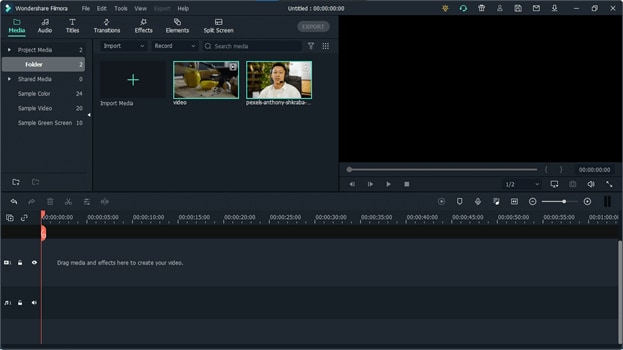
Step 03: Place both of these videos into the timeline. Make sure to place your reaction above.
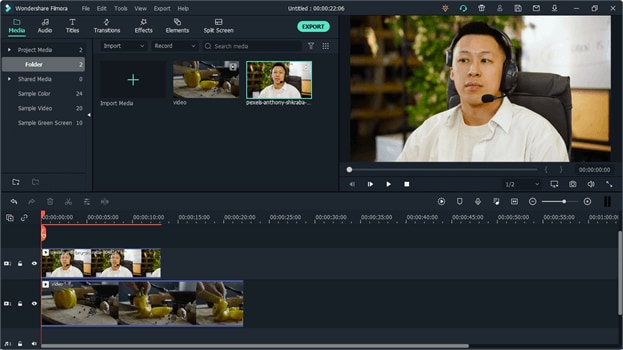
Step 04: Select your reaction video on the timeline and go to the “Effects”. Here you will find a new folder named “AI Portrait”, open it. Here you will find multiple AI portrait effects.
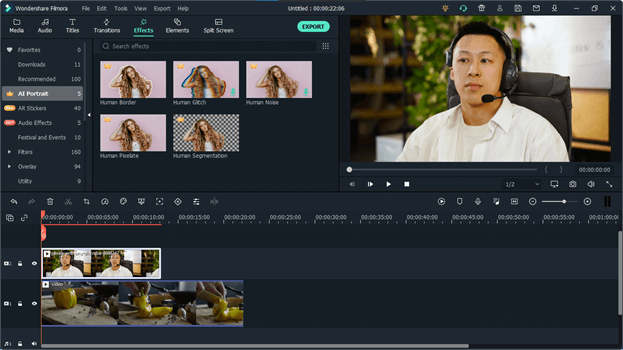
Step 05: Our goal is to remove the background of the reaction. To do that, we will use Human Segmentation. Drag and drop Human Segmentation into the reaction video. If you haven’t purchased this effect already, it will ask you to buy it to export the video. But you want to try it first, click on “Try It.”
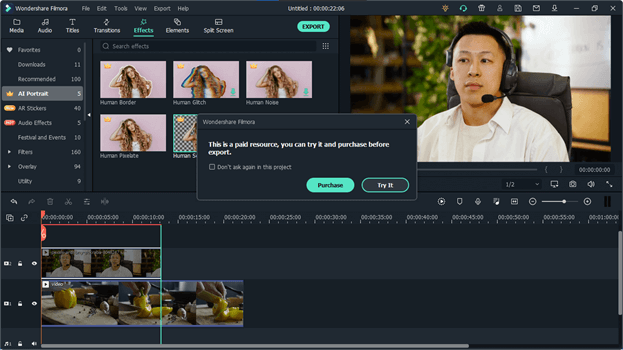
Step 06: Once the effect is successfully applied to the video, its background will be removed automatically.

Step 07: Adjust the video by making it smaller and place it in the bottom left corner of the screen. Your reaction video is ready to be uploaded on video-sharing platforms.
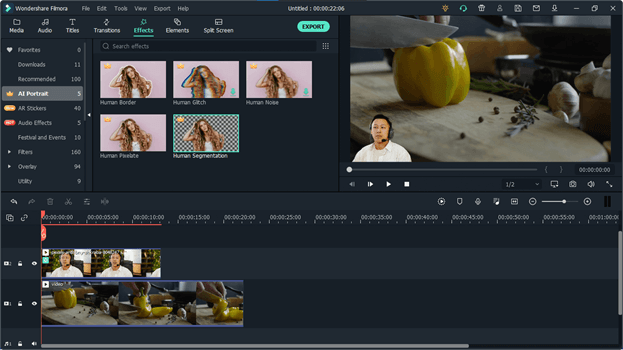
Step 08: To make your video look cool and stunning, you can also add multiple other effects to your reaction. AI portrait allows you to add a border around the character to make it look more visible and separate it from another video. Go to the AI portrait and drag Human Border Effect and drop it into your reaction. It will create an outline around the character and make it look more visible.
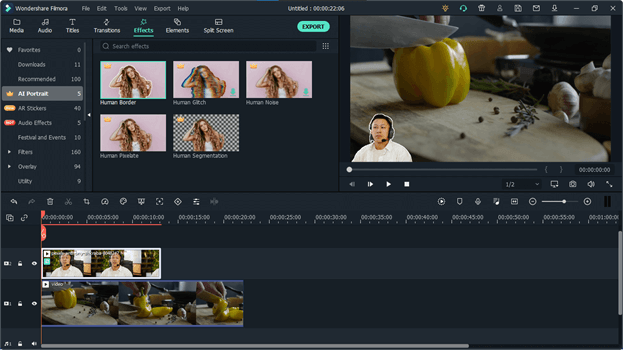
Step 09: In some instances, you might need to change the position or size of your reaction. You can easily do that by applying the Keyframes to it. If you feel like changing the part of your reaction at some point in the video, go to that point in the timeline and click on the keyframe button above the timeline.
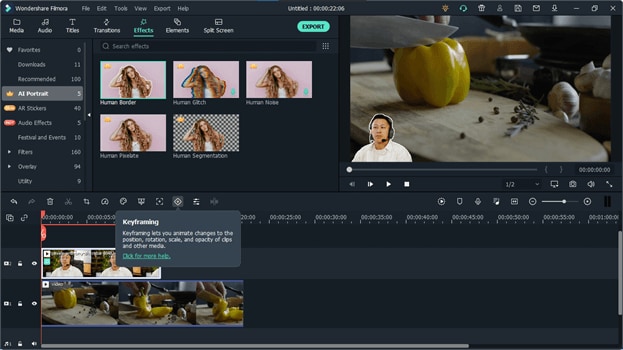
Step 10: Once you click on the keyframe, it will add a keyframe to the video. Now move forward into the timeline to a point and adjust your character’s position by dragging it. Let’s move it to the bottom right corner. It will add another keyframe to the video in the timeline. Now the character will change its position from the left corner to the right corner once it reaches that specific point in time.
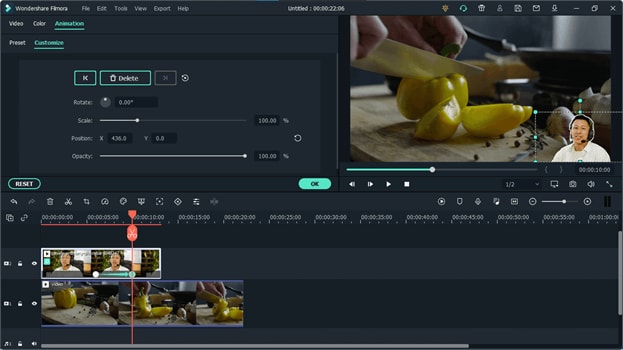
Conclusion
AI Portrait allows you to create wonderful effects using artificial intelligence. This is one of the best uses of AI to make stunning reaction videos. It will not only save you a lot of time but will also help you save a lot of money by helping you remove the background of your video without expensive materials such as a green screen and other materials related to it.

Liza Brown
Liza Brown is a writer and a lover of all things video.
Follow @Liza Brown
Liza Brown
Mar 27, 2024• Proven solutions
With several video-sharing platforms and billions of videos on those platforms, it is very difficult and competitive to make your mark and have an identity. There are hundreds of categories of videos that you can find on the platforms like Youtube, Dailymotion, Vimeo, and more. Among all those categories, reaction videos are one of the most popular categories. It allows a person to review another person’s opinion, view, or idea about any particular issue or instance. Most of the video-sharing platforms enable their users to make all kinds of reaction videos without any restriction. Having such a huge competition makes it hard to stand out and attract viewers.
Have you ever seen videos where the reactor has a transparent background instead of the rectangle box in the corner? They look nice and engaging, right? The process of making such videos will require so many materials such as a green screen, stand, and other materials to support it. It is difficult for everyone to afford all these and secondly, it is very difficult to carry from one place to another.
With Filmora X, you can create such transparent background reaction videos without such expensive material. Filmora has launched a new feature name AI Portrait that uses artificial intelligence to create amazing and cool effects. It uses the latest technology to separate the background and humans in the footage to help you remove the background with a single click. So, let’s get started with the process of making stunning reaction videos with Filmora’s AI Portrait.
You might be interested in:
Step 01: Open Filmora X. If it is not already installed on your PC, you can download it from here and install it on your PC.

Step 02: Import the video that you want to react to and your reaction video. If you have not already recorded your reaction, then record it first using any camera or smartphone.

Step 03: Place both of these videos into the timeline. Make sure to place your reaction above.

Step 04: Select your reaction video on the timeline and go to the “Effects”. Here you will find a new folder named “AI Portrait”, open it. Here you will find multiple AI portrait effects.

Step 05: Our goal is to remove the background of the reaction. To do that, we will use Human Segmentation. Drag and drop Human Segmentation into the reaction video. If you haven’t purchased this effect already, it will ask you to buy it to export the video. But you want to try it first, click on “Try It.”

Step 06: Once the effect is successfully applied to the video, its background will be removed automatically.

Step 07: Adjust the video by making it smaller and place it in the bottom left corner of the screen. Your reaction video is ready to be uploaded on video-sharing platforms.

Step 08: To make your video look cool and stunning, you can also add multiple other effects to your reaction. AI portrait allows you to add a border around the character to make it look more visible and separate it from another video. Go to the AI portrait and drag Human Border Effect and drop it into your reaction. It will create an outline around the character and make it look more visible.

Step 09: In some instances, you might need to change the position or size of your reaction. You can easily do that by applying the Keyframes to it. If you feel like changing the part of your reaction at some point in the video, go to that point in the timeline and click on the keyframe button above the timeline.

Step 10: Once you click on the keyframe, it will add a keyframe to the video. Now move forward into the timeline to a point and adjust your character’s position by dragging it. Let’s move it to the bottom right corner. It will add another keyframe to the video in the timeline. Now the character will change its position from the left corner to the right corner once it reaches that specific point in time.

Conclusion
AI Portrait allows you to create wonderful effects using artificial intelligence. This is one of the best uses of AI to make stunning reaction videos. It will not only save you a lot of time but will also help you save a lot of money by helping you remove the background of your video without expensive materials such as a green screen and other materials related to it.

Liza Brown
Liza Brown is a writer and a lover of all things video.
Follow @Liza Brown
Liza Brown
Mar 27, 2024• Proven solutions
With several video-sharing platforms and billions of videos on those platforms, it is very difficult and competitive to make your mark and have an identity. There are hundreds of categories of videos that you can find on the platforms like Youtube, Dailymotion, Vimeo, and more. Among all those categories, reaction videos are one of the most popular categories. It allows a person to review another person’s opinion, view, or idea about any particular issue or instance. Most of the video-sharing platforms enable their users to make all kinds of reaction videos without any restriction. Having such a huge competition makes it hard to stand out and attract viewers.
Have you ever seen videos where the reactor has a transparent background instead of the rectangle box in the corner? They look nice and engaging, right? The process of making such videos will require so many materials such as a green screen, stand, and other materials to support it. It is difficult for everyone to afford all these and secondly, it is very difficult to carry from one place to another.
With Filmora X, you can create such transparent background reaction videos without such expensive material. Filmora has launched a new feature name AI Portrait that uses artificial intelligence to create amazing and cool effects. It uses the latest technology to separate the background and humans in the footage to help you remove the background with a single click. So, let’s get started with the process of making stunning reaction videos with Filmora’s AI Portrait.
You might be interested in:
Step 01: Open Filmora X. If it is not already installed on your PC, you can download it from here and install it on your PC.

Step 02: Import the video that you want to react to and your reaction video. If you have not already recorded your reaction, then record it first using any camera or smartphone.

Step 03: Place both of these videos into the timeline. Make sure to place your reaction above.

Step 04: Select your reaction video on the timeline and go to the “Effects”. Here you will find a new folder named “AI Portrait”, open it. Here you will find multiple AI portrait effects.

Step 05: Our goal is to remove the background of the reaction. To do that, we will use Human Segmentation. Drag and drop Human Segmentation into the reaction video. If you haven’t purchased this effect already, it will ask you to buy it to export the video. But you want to try it first, click on “Try It.”

Step 06: Once the effect is successfully applied to the video, its background will be removed automatically.

Step 07: Adjust the video by making it smaller and place it in the bottom left corner of the screen. Your reaction video is ready to be uploaded on video-sharing platforms.

Step 08: To make your video look cool and stunning, you can also add multiple other effects to your reaction. AI portrait allows you to add a border around the character to make it look more visible and separate it from another video. Go to the AI portrait and drag Human Border Effect and drop it into your reaction. It will create an outline around the character and make it look more visible.

Step 09: In some instances, you might need to change the position or size of your reaction. You can easily do that by applying the Keyframes to it. If you feel like changing the part of your reaction at some point in the video, go to that point in the timeline and click on the keyframe button above the timeline.

Step 10: Once you click on the keyframe, it will add a keyframe to the video. Now move forward into the timeline to a point and adjust your character’s position by dragging it. Let’s move it to the bottom right corner. It will add another keyframe to the video in the timeline. Now the character will change its position from the left corner to the right corner once it reaches that specific point in time.

Conclusion
AI Portrait allows you to create wonderful effects using artificial intelligence. This is one of the best uses of AI to make stunning reaction videos. It will not only save you a lot of time but will also help you save a lot of money by helping you remove the background of your video without expensive materials such as a green screen and other materials related to it.

Liza Brown
Liza Brown is a writer and a lover of all things video.
Follow @Liza Brown
Liza Brown
Mar 27, 2024• Proven solutions
With several video-sharing platforms and billions of videos on those platforms, it is very difficult and competitive to make your mark and have an identity. There are hundreds of categories of videos that you can find on the platforms like Youtube, Dailymotion, Vimeo, and more. Among all those categories, reaction videos are one of the most popular categories. It allows a person to review another person’s opinion, view, or idea about any particular issue or instance. Most of the video-sharing platforms enable their users to make all kinds of reaction videos without any restriction. Having such a huge competition makes it hard to stand out and attract viewers.
Have you ever seen videos where the reactor has a transparent background instead of the rectangle box in the corner? They look nice and engaging, right? The process of making such videos will require so many materials such as a green screen, stand, and other materials to support it. It is difficult for everyone to afford all these and secondly, it is very difficult to carry from one place to another.
With Filmora X, you can create such transparent background reaction videos without such expensive material. Filmora has launched a new feature name AI Portrait that uses artificial intelligence to create amazing and cool effects. It uses the latest technology to separate the background and humans in the footage to help you remove the background with a single click. So, let’s get started with the process of making stunning reaction videos with Filmora’s AI Portrait.
You might be interested in:
Step 01: Open Filmora X. If it is not already installed on your PC, you can download it from here and install it on your PC.

Step 02: Import the video that you want to react to and your reaction video. If you have not already recorded your reaction, then record it first using any camera or smartphone.

Step 03: Place both of these videos into the timeline. Make sure to place your reaction above.

Step 04: Select your reaction video on the timeline and go to the “Effects”. Here you will find a new folder named “AI Portrait”, open it. Here you will find multiple AI portrait effects.

Step 05: Our goal is to remove the background of the reaction. To do that, we will use Human Segmentation. Drag and drop Human Segmentation into the reaction video. If you haven’t purchased this effect already, it will ask you to buy it to export the video. But you want to try it first, click on “Try It.”

Step 06: Once the effect is successfully applied to the video, its background will be removed automatically.

Step 07: Adjust the video by making it smaller and place it in the bottom left corner of the screen. Your reaction video is ready to be uploaded on video-sharing platforms.

Step 08: To make your video look cool and stunning, you can also add multiple other effects to your reaction. AI portrait allows you to add a border around the character to make it look more visible and separate it from another video. Go to the AI portrait and drag Human Border Effect and drop it into your reaction. It will create an outline around the character and make it look more visible.

Step 09: In some instances, you might need to change the position or size of your reaction. You can easily do that by applying the Keyframes to it. If you feel like changing the part of your reaction at some point in the video, go to that point in the timeline and click on the keyframe button above the timeline.

Step 10: Once you click on the keyframe, it will add a keyframe to the video. Now move forward into the timeline to a point and adjust your character’s position by dragging it. Let’s move it to the bottom right corner. It will add another keyframe to the video in the timeline. Now the character will change its position from the left corner to the right corner once it reaches that specific point in time.

Conclusion
AI Portrait allows you to create wonderful effects using artificial intelligence. This is one of the best uses of AI to make stunning reaction videos. It will not only save you a lot of time but will also help you save a lot of money by helping you remove the background of your video without expensive materials such as a green screen and other materials related to it.

Liza Brown
Liza Brown is a writer and a lover of all things video.
Follow @Liza Brown
Color Enhancement Essentials for Final Cut Pro Users
Color Correction in Final Cut Pro

Benjamin Arango
Mar 27, 2024• Proven solutions
Most of the advanced camera units these days are capable enough to produce shots with rich quality automatically but still some professionals need to edit captured videos for little color correction. The major reasons behind this additional color correction are:
- Some people need to correct their mistakes on captured videos; it can be due to an incorrect balance of white and due to under or over-exposure at some points.
- Customize different video clips by matching them so that they appear in sequence even if they are captured at different moments.
- For creating a specific style or look in order to support your mood; for example, one may need to make scenes appear cold, dark, cheery, warm, bright or foreboding.
No matter what you want to do for the customization of your videos, Final Cut Pro can provide your complete assistance. The details below can help you to collect complete information about color correction techniques.
The steps below can help all beginners to develop easy video edited projects using Final Cut Pro, but if some of you find this platform a little difficult then it is good to start practicing as a beginner on Wondershare Filmora for Mac . This is a well-known video editor tool for Mac users that contains all powerful features and an interactive user interface to facilitate all beginners.
 Download Mac Version ](https://tools.techidaily.com/wondershare/filmora/download/ )
Download Mac Version ](https://tools.techidaily.com/wondershare/filmora/download/ )
Related article:
Methods to Correct Color in Final Cut Pro
Those who wish to use FCP for color signal editing need to follow these steps:
Step 1
First you need to open Color Board on FCP as there is an automatic color correction tool available inside. The Video Board can be opened by using three different ways:
- You can select audio enhancement and color correction options available below the viewer and then hit “Show Color Board”. It can be simply done by pressing CMD + 6.

- On effect browser you can easily access color correction effects inside the color category; that is also easier to allocate.

- Choose Window and then click on Go To, you will find Color Board on the appeared drop-down menu.

- All the color correction effects will start appearing in the effects section available on the video inspector.

Step 2
As soon as you start working on Color Board, it is good to open Video Scopes on your system. For this you need to click on a small icon of light switch available at the top right corner of the viewer and then select Show Video Scopes from drop-down menu. It can be also done by simply pressing Command+7.

As soon as you make this selection, the video scopes window will automatically appear on the next viewer. Here users can easily obtain information related to the current video frame, and they can be easily configured as per need. Go to the settings option available on the top right side of the window and then hit the Waveform option.

Step 3
Now it is time to work on color correction directly. There are three types of color corrections that users need to work upon: Hue, Saturation, and Exposure. Here is some brief information about all of these:
Exposure or Brightness: On the Color board window you can easily make adjustments for brightness levels of video clips. As you move on to different portions of the image ranging between dark and white parts, the scope will keep on displaying waveforms with values between 0 and 100 representing darkness and brightness respectively. The master slider available on screen helps users to make overall adjustments for brightness by using three control options: highlights for white circles, midtones for gray scale and shadows for black parts. Consider waveform values as a guide for adjustment and move controls up and down to adjust contrast as per need.

Saturation: It refers to the richness of colors in an image. Simply select saturation pane from the color board and on the video scopes window you can use the settings menu directly to adjust saturation information for every pixel. The image pixels that are far away from the center of vectorscope circle means they are more saturated as compared to pixels that are little bit closure.

Hue: Hue displays the actual color values in images or frames in terms of primary colors: red, blue, and yellow. Use color pane from color board to adjust hue that is displayed in the form of a rainbow on screen. It is possible to manipulate values for highlights, midtones and shadows individually as per need. Using the histogram option available on settings menu can help you to make direct adjustments for all these components.

Step 4
It is possible to preview all the corrections on the original image before making them final. Simple hit the arrow with left-facing formation in the top left corner of the Color Board and then return to the video inspector. Hit on the Blue box to switch between correction On and Off options.

Here’s the video tutorial on how to correct color in Final Cut Pro:

Benjamin Arango
Benjamin Arango is a writer and a lover of all things video.
Follow @Benjamin Arango
Benjamin Arango
Mar 27, 2024• Proven solutions
Most of the advanced camera units these days are capable enough to produce shots with rich quality automatically but still some professionals need to edit captured videos for little color correction. The major reasons behind this additional color correction are:
- Some people need to correct their mistakes on captured videos; it can be due to an incorrect balance of white and due to under or over-exposure at some points.
- Customize different video clips by matching them so that they appear in sequence even if they are captured at different moments.
- For creating a specific style or look in order to support your mood; for example, one may need to make scenes appear cold, dark, cheery, warm, bright or foreboding.
No matter what you want to do for the customization of your videos, Final Cut Pro can provide your complete assistance. The details below can help you to collect complete information about color correction techniques.
The steps below can help all beginners to develop easy video edited projects using Final Cut Pro, but if some of you find this platform a little difficult then it is good to start practicing as a beginner on Wondershare Filmora for Mac . This is a well-known video editor tool for Mac users that contains all powerful features and an interactive user interface to facilitate all beginners.
 Download Mac Version ](https://tools.techidaily.com/wondershare/filmora/download/ )
Download Mac Version ](https://tools.techidaily.com/wondershare/filmora/download/ )
Related article:
Methods to Correct Color in Final Cut Pro
Those who wish to use FCP for color signal editing need to follow these steps:
Step 1
First you need to open Color Board on FCP as there is an automatic color correction tool available inside. The Video Board can be opened by using three different ways:
- You can select audio enhancement and color correction options available below the viewer and then hit “Show Color Board”. It can be simply done by pressing CMD + 6.

- On effect browser you can easily access color correction effects inside the color category; that is also easier to allocate.

- Choose Window and then click on Go To, you will find Color Board on the appeared drop-down menu.

- All the color correction effects will start appearing in the effects section available on the video inspector.

Step 2
As soon as you start working on Color Board, it is good to open Video Scopes on your system. For this you need to click on a small icon of light switch available at the top right corner of the viewer and then select Show Video Scopes from drop-down menu. It can be also done by simply pressing Command+7.

As soon as you make this selection, the video scopes window will automatically appear on the next viewer. Here users can easily obtain information related to the current video frame, and they can be easily configured as per need. Go to the settings option available on the top right side of the window and then hit the Waveform option.

Step 3
Now it is time to work on color correction directly. There are three types of color corrections that users need to work upon: Hue, Saturation, and Exposure. Here is some brief information about all of these:
Exposure or Brightness: On the Color board window you can easily make adjustments for brightness levels of video clips. As you move on to different portions of the image ranging between dark and white parts, the scope will keep on displaying waveforms with values between 0 and 100 representing darkness and brightness respectively. The master slider available on screen helps users to make overall adjustments for brightness by using three control options: highlights for white circles, midtones for gray scale and shadows for black parts. Consider waveform values as a guide for adjustment and move controls up and down to adjust contrast as per need.

Saturation: It refers to the richness of colors in an image. Simply select saturation pane from the color board and on the video scopes window you can use the settings menu directly to adjust saturation information for every pixel. The image pixels that are far away from the center of vectorscope circle means they are more saturated as compared to pixels that are little bit closure.

Hue: Hue displays the actual color values in images or frames in terms of primary colors: red, blue, and yellow. Use color pane from color board to adjust hue that is displayed in the form of a rainbow on screen. It is possible to manipulate values for highlights, midtones and shadows individually as per need. Using the histogram option available on settings menu can help you to make direct adjustments for all these components.

Step 4
It is possible to preview all the corrections on the original image before making them final. Simple hit the arrow with left-facing formation in the top left corner of the Color Board and then return to the video inspector. Hit on the Blue box to switch between correction On and Off options.

Here’s the video tutorial on how to correct color in Final Cut Pro:

Benjamin Arango
Benjamin Arango is a writer and a lover of all things video.
Follow @Benjamin Arango
Benjamin Arango
Mar 27, 2024• Proven solutions
Most of the advanced camera units these days are capable enough to produce shots with rich quality automatically but still some professionals need to edit captured videos for little color correction. The major reasons behind this additional color correction are:
- Some people need to correct their mistakes on captured videos; it can be due to an incorrect balance of white and due to under or over-exposure at some points.
- Customize different video clips by matching them so that they appear in sequence even if they are captured at different moments.
- For creating a specific style or look in order to support your mood; for example, one may need to make scenes appear cold, dark, cheery, warm, bright or foreboding.
No matter what you want to do for the customization of your videos, Final Cut Pro can provide your complete assistance. The details below can help you to collect complete information about color correction techniques.
The steps below can help all beginners to develop easy video edited projects using Final Cut Pro, but if some of you find this platform a little difficult then it is good to start practicing as a beginner on Wondershare Filmora for Mac . This is a well-known video editor tool for Mac users that contains all powerful features and an interactive user interface to facilitate all beginners.
 Download Mac Version ](https://tools.techidaily.com/wondershare/filmora/download/ )
Download Mac Version ](https://tools.techidaily.com/wondershare/filmora/download/ )
Related article:
Methods to Correct Color in Final Cut Pro
Those who wish to use FCP for color signal editing need to follow these steps:
Step 1
First you need to open Color Board on FCP as there is an automatic color correction tool available inside. The Video Board can be opened by using three different ways:
- You can select audio enhancement and color correction options available below the viewer and then hit “Show Color Board”. It can be simply done by pressing CMD + 6.

- On effect browser you can easily access color correction effects inside the color category; that is also easier to allocate.

- Choose Window and then click on Go To, you will find Color Board on the appeared drop-down menu.

- All the color correction effects will start appearing in the effects section available on the video inspector.

Step 2
As soon as you start working on Color Board, it is good to open Video Scopes on your system. For this you need to click on a small icon of light switch available at the top right corner of the viewer and then select Show Video Scopes from drop-down menu. It can be also done by simply pressing Command+7.

As soon as you make this selection, the video scopes window will automatically appear on the next viewer. Here users can easily obtain information related to the current video frame, and they can be easily configured as per need. Go to the settings option available on the top right side of the window and then hit the Waveform option.

Step 3
Now it is time to work on color correction directly. There are three types of color corrections that users need to work upon: Hue, Saturation, and Exposure. Here is some brief information about all of these:
Exposure or Brightness: On the Color board window you can easily make adjustments for brightness levels of video clips. As you move on to different portions of the image ranging between dark and white parts, the scope will keep on displaying waveforms with values between 0 and 100 representing darkness and brightness respectively. The master slider available on screen helps users to make overall adjustments for brightness by using three control options: highlights for white circles, midtones for gray scale and shadows for black parts. Consider waveform values as a guide for adjustment and move controls up and down to adjust contrast as per need.

Saturation: It refers to the richness of colors in an image. Simply select saturation pane from the color board and on the video scopes window you can use the settings menu directly to adjust saturation information for every pixel. The image pixels that are far away from the center of vectorscope circle means they are more saturated as compared to pixels that are little bit closure.

Hue: Hue displays the actual color values in images or frames in terms of primary colors: red, blue, and yellow. Use color pane from color board to adjust hue that is displayed in the form of a rainbow on screen. It is possible to manipulate values for highlights, midtones and shadows individually as per need. Using the histogram option available on settings menu can help you to make direct adjustments for all these components.

Step 4
It is possible to preview all the corrections on the original image before making them final. Simple hit the arrow with left-facing formation in the top left corner of the Color Board and then return to the video inspector. Hit on the Blue box to switch between correction On and Off options.

Here’s the video tutorial on how to correct color in Final Cut Pro:

Benjamin Arango
Benjamin Arango is a writer and a lover of all things video.
Follow @Benjamin Arango
Benjamin Arango
Mar 27, 2024• Proven solutions
Most of the advanced camera units these days are capable enough to produce shots with rich quality automatically but still some professionals need to edit captured videos for little color correction. The major reasons behind this additional color correction are:
- Some people need to correct their mistakes on captured videos; it can be due to an incorrect balance of white and due to under or over-exposure at some points.
- Customize different video clips by matching them so that they appear in sequence even if they are captured at different moments.
- For creating a specific style or look in order to support your mood; for example, one may need to make scenes appear cold, dark, cheery, warm, bright or foreboding.
No matter what you want to do for the customization of your videos, Final Cut Pro can provide your complete assistance. The details below can help you to collect complete information about color correction techniques.
The steps below can help all beginners to develop easy video edited projects using Final Cut Pro, but if some of you find this platform a little difficult then it is good to start practicing as a beginner on Wondershare Filmora for Mac . This is a well-known video editor tool for Mac users that contains all powerful features and an interactive user interface to facilitate all beginners.
 Download Mac Version ](https://tools.techidaily.com/wondershare/filmora/download/ )
Download Mac Version ](https://tools.techidaily.com/wondershare/filmora/download/ )
Related article:
Methods to Correct Color in Final Cut Pro
Those who wish to use FCP for color signal editing need to follow these steps:
Step 1
First you need to open Color Board on FCP as there is an automatic color correction tool available inside. The Video Board can be opened by using three different ways:
- You can select audio enhancement and color correction options available below the viewer and then hit “Show Color Board”. It can be simply done by pressing CMD + 6.

- On effect browser you can easily access color correction effects inside the color category; that is also easier to allocate.

- Choose Window and then click on Go To, you will find Color Board on the appeared drop-down menu.

- All the color correction effects will start appearing in the effects section available on the video inspector.

Step 2
As soon as you start working on Color Board, it is good to open Video Scopes on your system. For this you need to click on a small icon of light switch available at the top right corner of the viewer and then select Show Video Scopes from drop-down menu. It can be also done by simply pressing Command+7.

As soon as you make this selection, the video scopes window will automatically appear on the next viewer. Here users can easily obtain information related to the current video frame, and they can be easily configured as per need. Go to the settings option available on the top right side of the window and then hit the Waveform option.

Step 3
Now it is time to work on color correction directly. There are three types of color corrections that users need to work upon: Hue, Saturation, and Exposure. Here is some brief information about all of these:
Exposure or Brightness: On the Color board window you can easily make adjustments for brightness levels of video clips. As you move on to different portions of the image ranging between dark and white parts, the scope will keep on displaying waveforms with values between 0 and 100 representing darkness and brightness respectively. The master slider available on screen helps users to make overall adjustments for brightness by using three control options: highlights for white circles, midtones for gray scale and shadows for black parts. Consider waveform values as a guide for adjustment and move controls up and down to adjust contrast as per need.

Saturation: It refers to the richness of colors in an image. Simply select saturation pane from the color board and on the video scopes window you can use the settings menu directly to adjust saturation information for every pixel. The image pixels that are far away from the center of vectorscope circle means they are more saturated as compared to pixels that are little bit closure.

Hue: Hue displays the actual color values in images or frames in terms of primary colors: red, blue, and yellow. Use color pane from color board to adjust hue that is displayed in the form of a rainbow on screen. It is possible to manipulate values for highlights, midtones and shadows individually as per need. Using the histogram option available on settings menu can help you to make direct adjustments for all these components.

Step 4
It is possible to preview all the corrections on the original image before making them final. Simple hit the arrow with left-facing formation in the top left corner of the Color Board and then return to the video inspector. Hit on the Blue box to switch between correction On and Off options.

Here’s the video tutorial on how to correct color in Final Cut Pro:

Benjamin Arango
Benjamin Arango is a writer and a lover of all things video.
Follow @Benjamin Arango
Also read:
- New 2024 Approved Transfer Videos to DVD Discs on Windows and Mac Computers
- Learn How to Choose a Proper Video Editor for Videos Shot by Canon Camcorders
- New TiVo or Comcast Which DVR Is Right for You , In 2024
- Updated Windows 10 Video Trimmer Showdown Top 10 Free Options for 2024
- Updated 2024 Approved Wish to Edit Your MP4 Files in OS X 10.9 Mavericks? Video Editor for Mac Is Provided for You
- New Optimize Your LinkedIn Videos A Guide to Custom Thumbnails for 2024
- Updated S Best GoPro Editing Tools Replacing GoPro Studio with These Alternatives for 2024
- 2024 Approved MP4 to MP3 Conversion on Mobile The Best Apps and Tools
- Updated 2024 Approved FCP X Effects Made Simple A Quick 3-Step Tutorial
- New In 2024, Reaction Video Maker Top Picks for iPhone and Android
- Updated 2024 Approved Get Noticed Best Practices for Instagram Video Dimensions
- Updated Create Stunning Lyric Videos with These Online Tools
- Movie Magic Made Simple A Step-by-Step Guide
- New Free Adobe Premiere Pro CS6 for Mac - No Subscription Required
- Bypass Filmora Watermark Free and Paid Workarounds for 2024
- New 2024 Approved The Top 10 Stop Motion Animation Tools You Need to Know
- New In 2024, Create Stunning Loops Best Free GIF Software
- New 2024 Approved From Shaky to Stable The Top 5 Free Video Stabilizer Apps for Android
- Unlock the Power of Microsoft Video Editor Windows Video Editing Tips and Tricks for 2024
- New GoPro Quik for PC and Alternatives for 2024
- How To Change Your Apple ID Password On your iPhone 14 Pro Max | Dr.fone
- Identify missing your hardware drivers with Windows Device Manager in Windows 11/10/7
- Top-Notch Solutions for Disabled Apple ID On iPhone 12 Pro Max Making It Possible
- In 2024, What is the best Pokemon for pokemon pvp ranking On Vivo Y200? | Dr.fone
- Pokemon Go Error 12 Failed to Detect Location On Apple iPhone SE (2020)? | Dr.fone
- How To Fix Unresponsive Touch Screen on Xiaomi Redmi Note 13 5G | Dr.fone
- How to recover old messages from your Google Pixel 8 Pro
- 7 Ways to Unlock a Locked Vivo S17t Phone
- In 2024, Step-by-Step Tutorial How To Bypass Oppo F23 5G FRP
- How does the stardust trade cost In pokemon go On Samsung Galaxy A05s? | Dr.fone
- How to Transfer Videos from Vivo Y36 to iPad | Dr.fone
- How to retrieve erased messages from Honor Magic 6 Lite
- In 2024, Tips and Tricks for Apple ID Locked Issue On iPhone 6s
- Updated How to Turn On/Off Motion Blur in Minecraft, In 2024
- How to Perform Hard Reset on Poco C50? | Dr.fone
- In 2024, Top 10 AirPlay Apps in Infinix Zero 30 5G for Streaming | Dr.fone
- Possible ways to recover deleted files from ZTE Axon 40 Lite
- Today I Configure MT4 and MT5 Accounts
- In 2024, New Guide How To Check iCloud Activation Lock Status On Your Apple iPhone 15
- How To Transfer WhatsApp From iPhone 11 Pro Max to other iPhone 12 Pro Max devices? | Dr.fone
- Title: Updated 2024 Approved Unlocking Advanced Video Editing Picture-in-Picture in Final Cut Pro
- Author: Amelia
- Created at : 2024-06-16 10:10:17
- Updated at : 2024-06-17 10:10:17
- Link: https://ai-driven-video-production.techidaily.com/updated-2024-approved-unlocking-advanced-video-editing-picture-in-picture-in-final-cut-pro/
- License: This work is licensed under CC BY-NC-SA 4.0.


